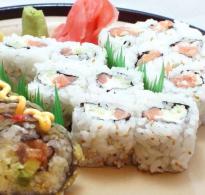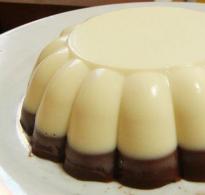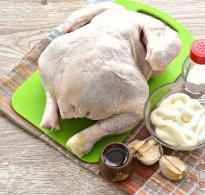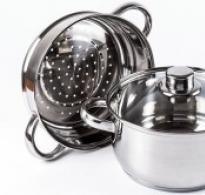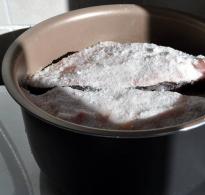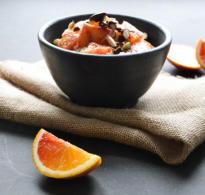How to store vegetables and fruits for a long time. Optimal storage conditions and temperatures for vegetables and fruits
The entire summer cottage season is spent on the beds in an attempt to grow a rich harvest of vegetables and fruits. But when it's time to harvest, not everyone knows how to keep vegetables and fruits fresh for a long time.
There are little tricks in which you can be content with your harvest until spring.

Of course, the whole process is based on maintaining the optimum temperature. So, potatoes are our second bread, and many stock up on them for the winter, but not many keep them long enough as they would like. The optimal storage temperature for potatoes is + 2-3 ° C, it can be achieved through special structures, insulated boxes, store the vegetable on glazed balconies if you do not have cellars and basements. If the temperature is three degrees higher than it should be, then the potatoes will begin to sprout, and if it drops, then it will acquire a sweetish taste.
In addition, the second storage condition is air humidity; for potatoes, it should not be low.
That is why it is necessary in the summer to think about the room where you are going to store potatoes, if necessary, insulate it, dry it well and ventilate it.
Storing carrots and cabbage

Carrots must be stored in a box covered with sand.
It is very difficult to preserve carrots, as they require special attention. After cleaning it from the garden, in no case does it need to be washed, as this can lead to the development of various diseases. It is placed in boxes and sprinkled with sand or onion husks and removed to the cellar or balcony, where the temperature should be from +2 to + 4 ° C.
The surest way to preserve carrots is to grind or dice them and put them in the freezer.

Cabbage can be stored hanging in the cellar.
Cabbage is stored at a lower temperature, closer to 0 ° C with deviations of +/- 1 ° C. It can be stored in the refrigerator, in insulated boxes on the balcony, on shelves, or suspended in a cellar. You can use a newspaper and wrap each head of cabbage and put it at a short distance from each other in a cool place. Of course, the best place to store cabbage is in the cellar, since there are the most favorable conditions for storing cabbage in winter: high humidity, low temperature and good ventilation. The floor on which you will lay the cabbage in the nets must be covered with oilcloth to prevent it from touching the ground or other dirty surface.
The storage conditions for cauliflower are the same. The only thing is that you cannot put cauliflower in nets, for each head of cabbage it must be separate in order to increase air access. Hang each net from the ceiling to keep the cauliflower fresh longer.
Back to the table of contents
Storing beets, onions and garlic

There are no problems with storing beets, you can do the same with carrots, sprinkle them with sand and put them in a cool place, where the temperature is + 2-4 ° C. That is, a cellar or basement is a good place to store it. Beets are better preserved than carrots and potatoes if they are properly harvested from the beds and maturing varieties are selected. The best way to store beets is to keep them together with potatoes. You need to scatter the beets on top of it, and it will absorb the excess moisture released by the potatoes, thereby protecting it from waterlogging.

To preserve garlic and onions, they must first be well dried and put in cloth or paper bags and stored on the bottom shelf of the refrigerator. You can also store onions at room temperature in well-ventilated boxes or boxes that need to be drilled with holes for good ventilation. Another true and old way of storing onions is to braid them, if they have feathers left after harvesting, and hang them up. The optimum storage temperature for onions and garlic is from 0 to + 6 ° C. But it should be borne in mind: if you correctly removed the garlic and onions from the garden, then the shelf life will be extended.
Back to the table of contents
Storing pumpkin and perishable food

Pumpkin and zucchini can also be stored, their storage temperature is + 6-12 ° C. A prerequisite for long-term storage of zucchini and pumpkin is a dry room, otherwise ulcers appear on their surface, which lead to spoilage of the product.
And, perhaps, the most perishable vegetables are tomatoes, cucumbers, peppers and eggplants. It is not possible to keep them fresh as long as the above vegetables. So, unripe tomatoes are best stored in boxes at room temperature, where they are stacked in three layers. The layers can be sprinkled with peat or sawdust, as the fruits ripen, they move and the ripe fruits are removed to a cooler place, but not to the refrigerator, where the tomatoes lose their taste and quickly become unusable. The main secret of the fast and uniform ripening of tomatoes is their harvesting from the garden along with the stalks.
But cucumbers are better stored in the refrigerator, they can be placed in a vacuum container on the lower shelf. So, at temperatures from 0 to 1 degrees, cucumbers can lie for only about 20 days.
Back to the table of contents
Storing bell peppers and eggplant

Bell peppers in biological maturity are stored in the refrigerator, they are placed in plastic bags, in which it is imperative to make small holes for ventilation. If you have a rich harvest of pepper and it did not have time to ripen, then we put it in boxes and store it at room temperature, while monitoring the ripening process. As soon as ripe peppers appear, they must be removed from the common box so that the gas they release does not accelerate the ripening process for other fruits. And it is best to freeze the pepper, while it retains its taste and useful qualities.
Eggplants also spoil quickly and prevent us from enjoying them on cold winter days. Store eggplants in a dark place at temperatures up to + 2 ° C. Under these conditions, eggplants are stored for just over a month. It is not recommended to store them in the refrigerator, as they quickly deteriorate there. You can wrap each eggplant in paper and put it on a shelf or in boxes and put them away in a dark and cool place.
An important condition for long-term storage of vegetables is the careful selection of all vegetables for storage: only healthy, unaffected vegetables are selected. Thus, if you monitor the storage process and remove spoiled vegetables in time, you can extend the shelf life.
Here are some tricks to help you improve your fruit and vegetable storage!
Keep vegetables away from moisture
This may sound strange, but you shouldn't wash the groceries you brought from the store before you send them to the refrigerator or on the shelf. If anything is dirty, just wipe it off with a tissue or dry cloth. Washing disrupts natural defense processes. 
Fruits and vegetables love dryness
Moisture causes mold. A good way to avoid this is to place a paper towel inside a fruit or vegetable container. This will remove moisture and protect food from rotting. 
Store avocados properly
Unripe avocados should be kept in a paper bag or newspaper. The temperature should be at room temperature. After ripening, it is better to put them in a plastic bag and send them to the refrigerator, there they will last longer and will not ripen further. 
Some fruits and vegetables cannot be kept cold.
Bell peppers, cucumbers and tomatoes should be kept in the room. Peppers lose their texture if refrigerated, and cucumbers and tomatoes can become sluggish. In addition, unripe fruits or vegetables should not be kept in the refrigerator, as this will accelerate the decay process. 
Wrap banana cuttings
If bananas are stored in the refrigerator, they quickly turn black and lose their flavor. It is best to keep them somewhere in the kitchen by simply wrapping the cuttings with plastic wrap. 
Keep pieces of vegetables in water
You can keep chopped vegetables like carrots or celery in the refrigerator for a long time. To do this, you just need to place them in water containers, it is simple and convenient. 
Keep food warm in the refrigerator
The lower the temperature, the more difficult it is to maintain the aroma and freshness of fruits and vegetables. If you want to keep the taste in order, keep food in the dedicated compartment. If you put them on other shelves, especially near the far wall, they will freeze and lose all their qualities. 
Certain varieties of vegetables and fruits cannot be kept nearby
Some products cannot be placed side by side. For example, bananas, apricots, melons, pears, plums, mangoes, and tomatoes actively release ethylene after ripening. Apples, eggplants, potatoes, pumpkins, watermelons, carrots, and broccoli are sensitive to ethylene, causing them to rot. Be aware of this feature and do not place the above groups of vegetables and fruits in the neighborhood in order to keep them fresh for longer. 
Onions and potatoes cannot be kept close
If you keep potatoes next to onions, they will sprout and become inedible. Always store onions separately from potatoes. 
Garlic and onions love the dark
Garlic and onion's best friend is darkness. If you do not have a large, unlit room, you can simply store food in tight paper bags with a few small holes for ventilation. In this case, they can be stored even in a well-lit kitchen. 
Potatoes spoil in direct sunlight
Do not store potatoes in direct sunlight. The tubers will start to rot and become dangerous. It is better to keep them in the dark and cool by placing them in an open box with good air ventilation. 
Store apples with potatoes
If you add an apple to a potato, the latter will stay fresh for much longer. 
Asparagus should be stored in the same way as a bouquet of flowers.
Keep the asparagus in a glass of water like a flower bouquet. This will keep it fresh longer. 
Broccoli and cauliflower love moisture
Broccoli should be stored with the stem in a glass, covered with a damp towel on top. The water needs to be changed regularly. You can also wrap cauliflower with a towel or plastic wrap. 
Vegetables need ventilation
Vegetables should not be hidden in a cupboard as they will deteriorate faster. It is much better to place them in ventilated wooden or plastic boxes. 
Wrap the celery in foil
Celery will stay cool and foil longer. In plastic, it loses its taste. 
Tomatoes should be stored upside down
The area around the cutting is the most delicate, from which the vegetable begins to rot. Store the tomatoes upside down. 
Grapes stay fresh longer if kept in a bag
The plastic bag will preserve the juiciness and freshness of the grapes. Do not store it in a large bunch: the bottom will be spoiled.
Bright, juicy and fragrant fruits are a decoration of any diet, therefore, paying at the supermarket checkout, we are sure that we have not spent in vain - we have provided ourselves and loved ones with vitamins. The habits of modern people are dictated by total employment and the presence of a refrigerator, which is available in almost every home. Many people prefer to buy a supply of food immediately for a week, so as not to waste time on daily shopping trips. And in this grocery set, fruits are almost always present. It is worth considering in more detail how to properly store fruits at home so that they do not lose their beneficial properties and appetizing appearance.

Conditions and terms of storage in the refrigerator
In points of sale, optimal conditions have been created for the preservation of fruits according to SanPiN. These standards are controlled by the state. A few simple rules will help to ensure the safety of fruits at home. Most of us, following the habit, load all the fruits into the refrigerator, although this is not always rational. Usually, people do this, because they are convinced that the safety of food at home can only be guaranteed in the temperature regime of the refrigerator. But this is not entirely true when it comes to delicate and capricious fruits.
The desire to preserve exotic fruits at low temperatures often leads to the opposite result - they rot, damp or become saturated with extraneous odors.


There are a few simple guidelines worth paying attention to.
- First of all, this applies to fruits grown in southern latitudes. They cannot withstand temperatures below 8 degrees, so their place in the refrigerator is on the lowest shelves or in special compartments. At the same time, delicate fruits do not like crampedness - you cannot fill containers to capacity, the air must circulate freely.


- Any fruit can be bought regardless of the season, but the storage conditions are different for everyone. It is not worth keeping in mind all the nuances, since high standards of GOSTs were developed back in the days of the Soviet Union. These universal storage rules are summarized in the table below for your convenience. You can print it out and keep it in front of your eyes in the kitchen.
oranges | from -1 to +10 degrees |
apricots | -1 to 0 degrees |
from +7 to +13 degrees |
|
from +2 to +21 degrees |
|
ripe bananas | from +13 to +16 degrees |
unripe bananas | from +16 to +21 degrees |
grape | from -1 to +3 degrees |
from -3 to +10 degrees |
|
from 0 to -2 degrees |
|
grapefruit | from +10 to +16 degrees |
from 0 to +13 degrees |
|
from 0 to +2 degrees |
|
from +9 to +14 degrees |
|
from +2 to +21 degrees |
|
from +10 to +13 degrees |
|
tangerines | from 0 to +8 degrees |
nectarines | from -0.5 to 0 degrees |
-1 to 0 degrees |
|
from -0.5 to +1 degrees |
|
from -1 to +2 degrees |
|
from -1 to +4 degrees |


Some fruits can be saved by placing them in the freezer. This method is great for apples, pears, plums, apricots, peaches and grapes. Wash the fruit before freezing. Cut apples and pears into slices. Remove seeds from peaches, plums and apricots. Then they can be laid out in plastic containers. Frozen fruit is a great filling for pies and tastes indistinguishable from fresh ones.


How else to place the fruits?
The refrigerator is perceived by many modern people as the only place to store food, but this is not entirely true. Many fruits do not need to be kept at a low temperature, since it has a detrimental effect on them. Fruits grown in hot climates can lose more than half of their vitamins after a few days spent on the refrigerator shelf: bananas will become covered with dark spots, melons and watermelons will become tasteless under the influence of cold. If the house has a cool pantry or cellar, then it is better to keep the fruit there. If there is no such room - on the kitchen table, in cupboards or on the balcony.

Juicy and overripe tropical fruits should not be purchased for future use, they deteriorate very quickly. Therefore, take a little to eat on the day of purchase. The rest can be used to make compotes, jam or dessert. Almost all fruits keep well at room temperature if protected from direct sunlight. If possible, place them in the dark.



Citrus fruits can be placed in a fruit bowl and placed on the table so that they are in front of everyone at home. If the family is large and several kilograms are bought at once, it is worth placing oranges (tangerines, grapefruits) in a cardboard box and spreading them out as needed. On the table, citruses will last from three days to a week, depending on the variety and degree of ripeness. Eco-friendly packaging is preferable for storing any fruit: paper bags, cardboard boxes, special containers, wooden boxes.



Cut fruits should not be stored at room temperature, they attract flies and fruit gnats. It is best to eat them as soon as possible, before they dry up or put them in the refrigerator for a short time. This also applies to melons: whole watermelons and melons tolerate room temperature well, but cut ones do not. They must be placed in the refrigerator, but not more than a few days. Sealed cellophane containers (packages, pallets) are categorically unsuitable for fruits, since ripe ones in it rot, and unripe ones do not ripen. Many of the fruits grown in southern latitudes are harvested immature so that they can be safely transported over long distances. At room temperature, they quickly become sweet and juicy.

Which fruits should not be put together?
It is important to keep in mind that some fruits are incompatible during storage. They literally destroy each other, lying side by side on a table or refrigerator shelf. The reason for the phenomenon is ethylene gas, which is odorless and colorless, which accelerates the maturation process. The aura of apples is especially saturated with ethylene, next to which the risk of overripe and rotting increases significantly. But this property can be used for peaceful purposes: if you put a ripe apple together with a green banana or hard pear, the latter will ripen much faster. When you buy unripe fruit that is high in ethylene, set it to a gas trap by placing it in a paper bag and closing it. The gas emitted by them, accumulating, will accelerate the maturation.


The following fruits must be stored with care:
- bananas;
- apricots;
- figs;
- avocado;
- melons;
- nectarines;
- peaches;
- pears;
- plums.




All of them are champions in ethylene content. Especially a lot of this gas is emitted by overripe, rotten and damaged fruits.
- after the fruits are at your home, carefully examine them - there may be spoiled berries on the bunches of grapes, crumpled sides of peaches and apricots; be sure to separate the damaged fruits from the whole, so it will be easier to keep them fresh for a long time;
- unwashed fruits that are intended for the refrigerator are best placed in a spacious bag or left in the original supermarket packaging; if storage at room temperature is expected, they must be removed from the package immediately;

- fruits and vegetables cannot be kept together - this rule applies to both the refrigerator and kitchen cabinets, for example, figs and grapes, after being adjacent to onions, absorb its smell;
- any overripe fruits should be kept in the refrigerator;
- fruits that need to ripen do not need to be put in the refrigerator, where they can lose most of the vitamins, without reaching ripeness; put them in a paper bag and leave them on the table or in the kitchen cabinet;
- apricots cannot be kept next to an avocado, since the latter has a pleasant, but very delicate aroma, apricots interrupt it;
- in some cases, polyethylene can keep the bananas safe; they should wrap the legs, linked together, and the fruit will hold out perfectly for several days at room temperature;

- plums are stored in the refrigerator, they are washed only before serving, so as not to wash off the white bloom, because it is he who protects the fruits from drying out;
- grapes are also stored unwashed in the refrigerator; in the cold, its shelf life is up to two weeks;
- apples, with a lack of moisture, wrinkle, therefore, it is better to place them in the refrigerator for long-term storage, placing them separately from other products;
- ripe and juicy pears should be bought in small quantities, they deteriorate very quickly, even in the refrigerator, such fruits are stored for up to two days;
- unripe pears can be taken for future use, put in paper bags and left at room temperature, so they ripen quickly;

- the longest shelf life for unripe Asian pears is up to three weeks in the refrigerator;
- limes and lemons, being in the refrigerator, can become saturated with foreign odors, so it is better to keep them on the table, where they are stored for up to a week;
- the place for storing strawberries is a refrigerator, but these delicate berries, even at low temperatures, begin to deteriorate after a few days;
- for storage, strawberries need to be spread out in the refrigerator in a thin layer so that they are not subjected to pressure.

The intricacies of storing fruit are described in the video below.
Ecology of consumption: Ripe vegetables and fruits are famous for the highest vitamin content. But how do you know if a banana is ripe or, for example, a pineapple?
Ripe vegetables and fruits are famous for the highest vitamin content. But how do you know if a banana is ripe or, for example, a pineapple? Good indicators in such cases are the color and smell of a particular vegetable or fruit. Naturally, no one would come up with the idea of peeling a banana and taking a bite. It is even harder with pineapple: by its appearance it is hardly possible to determine whether it is yellow, or even green. And here the smell will help us: if the pineapple exudes a typical aroma, then it is ripe. The smell determines the ripeness of other fruits, for example, honey melon, mango.
What happens with long-term and improper storage?
Improper storage of vegetables and fruits destroys vitamins, which are very sensitive to changes in temperature and light. The pulp of the fruit deteriorates, the fruit itself becomes nondescript and inedible. So, for example, when storing a banana in the refrigerator, like many tropical fruits that are not used to low temperatures, it loses its taste and aroma. The best solution in this case is to store them at room temperature.
What can and cannot be stored in the refrigerator?
You can store in the refrigerator:
Fruits: apples, apricots, pears, strawberries, figs, cherries, kiwi, nectarine, plums, peaches, table grapes.
Vegetables: artichoke, lettuce, cauliflower, broccoli, carrots, cabbage, radishes, Brussels sprouts, red beets, celery, asparagus, spinach
Do not refrigerate:
Fruits: pineapple, avocado, banana, pomegranate, mango, papaya, citrus, melon. Vegetables: eggplant, cucumber, green beans, potatoes, pumpkin, peppers, tomatoes, zucchini.
What does "correct storage" mean?
Previously, every house had a cellar and storage room. It was always cool and dark there, which in itself is an ideal place to store vegetables and fruits. Today we have basically only a refrigerator at our disposal.
Those who do not have a cellar should pay attention to the fact that vegetables and fruits cannot be stored in warm and bright rooms. Whatever it was, but in every apartment there is a corner, cooler and darker than the rest.
Store your vegetables and fruits there. But apples are always separate, because they release ethylene, which causes the rest of the fruits to overripe.
The following vegetables and fruits are sensitive to the most important ripening hormone - ethylene:
Very high sensitivity to ethylene in kiwi, honeydew, mango, broccoli, cauliflower, cabbage and Brussels sprouts.
High sensitivity in apricots, bananas, pears, nectarines, peaches, papaya, avocado, cucumbers, tomatoes.
Medium sensitivity in citrus fruits, leafy vegetables, potatoes, paprika, mushrooms, onions. Always store apples separately!
What to do with unripe vegetables and fruits?
Some fruits are harvested fully ripe, while others are still green. For example, such southern fruits as bananas, in order to bring them in a marketable form to our northern latitudes, are harvested green. They ripen on the way and at vegetable bases. Some domestic fruits, such as tomatoes and apples, are harvested and sold unripe. Half green, unripe tomatoes ripen well in clay pots.
Fruits that ripen:
apples, apricots, avocados, bananas, pears, blueberries, figs, guayava, kiwi, mango, nectarine, papaya, peaches, plums, tomatoes, watermelons.
Fruits that do not ripen:
pineapples, raspberries, strawberries, blackberries, cherries, tangerines, grapes, citrus fruits, eggplants, cucumbers, paprika.
What to do with brown spots?
It often happens that brown spots appear on the fruits even in supermarkets. This means that fetal tissue is damaged. Such fruits contain much less vitamins than healthy ones. Therefore, when buying, you need to carefully consider the product. If you notice such dark spots on homemade vegetables and fruits that have appeared as a result of stagnation, they must be cut out, and the rest of the fruit should be used as usual.
And I would also like to give some advice regarding the winter storage of vegetables and fruits. In the conditions of modern buildings, it is sometimes quite problematic to properly keep fresh vegetables and fruits throughout the winter. The warm and dry basements of modern houses are wrapped in an airtight concrete corset. Therefore, observing certain conditions, the autumn harvest can still be kept fresh and edible until the end of winter.
A wooden box filled with sand is suitable for storing all root vegetables. The sand must be wet!
The boxes with potatoes should be stored in a dark room (potatoes will germinate in the light). Store separately from apples. Apples produce a germinating agent for potatoes.
Store apples and pears in wooden crates or wooden trellises in a cool, well-ventilated area. Cover them with a damp cloth to stop evaporation. The fruit will retain its aroma for a long time and will not wrinkle so quickly.
How to store fruits and vegetables Store cereals in wooden boxes or paper bags, shake them from time to time.
Vegetables and fruits can be dried in a tumble dryer or oven. Dried vegetables and fruits should be stored in a dry, well-ventilated place.
Dry, well-ventilated areas are suitable for drying onions and garlic on a string. Bushes with unripe tomatoes, herbs, flowers should be stored in a dry place and suspended. published by
Storage of vegetables and fruits
Fruits and vegetables are essential for a balanced and healthy diet. as well as cereals, meat and dairy products. They provide us with important nutrients: vitamins, minerals and fiber. Fruits and vegetables deteriorate quickly due to improper storage. In addition, vitamins are especially sensitive to temperature and light. This means that proper storage of vegetables and fruits allows you to preserve vitamins for a long time. In this article, you will discover how to store vegetables and fruits, keeping them fresh and full of healthy ingredients for a long time.
Proper storage of vegetables and fruits
Different fruits and vegetables require different storage conditions. Temperature and humidity play a particularly important role in the proper storage of vegetables and fruits, depending on their origin.
Most of the population stores fruits and vegetables in the refrigerator without hesitation. On the other hand, for tropical fruits like bananas or melons, this is not the right place at all. Due to the low temperature, the cells of the tissues of the fetus are damaged, and the bananas become covered with brown spots. It is best to store vegetables and fruits grown in southern climates at temperatures between 8 and 13 degrees.
If vegetables and fruits are stored in a cooler place, they lose up to 70 percent of their vitamins after just two days. In addition to heat, vitamins are very sensitive to light. Therefore, fruits and vegetables that are not in your refrigerator are best kept in a dark place.
Temperature is critical
The following fruits and vegetables can be stored safely in the refrigerator:
Fruits: apricots, pears, peaches, nectarines, cherries, strawberries, blueberries, raspberries, gooseberries, currants, grapes, kiwi and plums
Vegetables: Broccoli, cauliflower, carrots, kohlrabi, mushrooms, corn, leeks, lettuce, spinach, radishes, Brussels sprouts, asparagus, Chinese cabbage, and green peas.
Fruits stored in the refrigerator should be placed in open plastic bags to prevent the fruit from drying out.
Slightly warmer - the ideal temperature for storing vegetables and fruits from warm countries is 8-13 degrees.
Fruits: melon, mango, lemon, papaya, pineapple and grapefruit
Vegetables: tomatoes, bell peppers, zucchini, cucumbers, onions, potatoes, garlic and eggplant
The easiest way to store them is in the basement or closet. This is much better because it is too warm at room temperature and too cold in the refrigerator for long-term storage. Bananas are best kept at 12 to 15 degrees.
How to store fruit
How to store vegetables and fruits
- Apples: Apples become wrinkled over time because they lose water. Therefore, it is best to store apples in a damp room, such as a basement. Apples should never be stored with other fruits because they release a lot of ethylene.
- Bananas: Bananas are not stored in the refrigerator because they quickly turn brown spots there. In a cool dry place, bananas can be stored for up to 3-4 days.
- Strawberries: Strawberries should only be stored in the refrigerator. These berries are very tender and quickly deteriorate, so they are stored for no more than two days. The strawberries must also be stored so that the berries are not subjected to any pressure, otherwise you will end up with a sweet bruised fruit.
- Melon: Melons are best stored in a basement or cool closet. If the melon has already been cut, it is best to keep it wrapped in plastic wrap.
- Plums: Plums should be stored unwashed in the refrigerator. Thanks to the white bloom that covers the plums, the fruits are protected from drying out.
- Grapes: Grapes like plums should also be washed just before eating. Otherwise, the grapes dry out faster.
- Cucumbers: Cucumbers should not be kept in the refrigerator. They stay fresh for a long time at a temperature of about 15 degrees. Therefore, cucumbers are best stored in the basement or closet.
- Carrots: Carrots can be stored in the refrigerator - preferably in a perforated plastic bag. The tops should be cut off. As it continues to grow, it uses up water and carrots may wrinkle.
- Asparagus: Asparagus is best eaten as fresh as possible. Store wrapped in a towel in the refrigerator for no more than 24 hours.
- Tomatoes: Tomatoes in the refrigerator where they rot quickly. They should be stored in a cool, dry place. Tomatoes should never be stored with other vegetables as they release a lot of ethylene.
- Zucchini: Zucchini, like cucumbers, is very sensitive to cold. It is best to keep them in a cool, dark place.
For the correct storage of vegetables and fruits, you must know that tomatoes and apples should not be stored together with other fruits and vegetables. They have been found to release ethylene in large quantities. This gas drives the ripening process and thus ensures that fruits and vegetables ripen and spoil faster. Other fruits, such as bananas or apricots, also release ethylene, albeit in lower amounts than apples and tomatoes.
If you bought an unripe fruit, you can take advantage of this effect: place an apple or tomato in an unripe fruit, and the ripening process will be accelerated.
Remember that different types of vegetables such as cucumbers, cauliflower, lettuce, and cabbage are very sensitive to ethylene; these fruits and vegetables should always be stored separately.
Despite all the advice on how to store vegetables and fruits, you should always keep in mind that fruits and vegetables are best eaten fresh. The storage of vegetables and fruits should not be too long, because even if vegetables and fruits are stored in optimal conditions, they lose valuable nutrients all the time. Therefore, buy as many fruits and vegetables as you need for the next two to three days.

